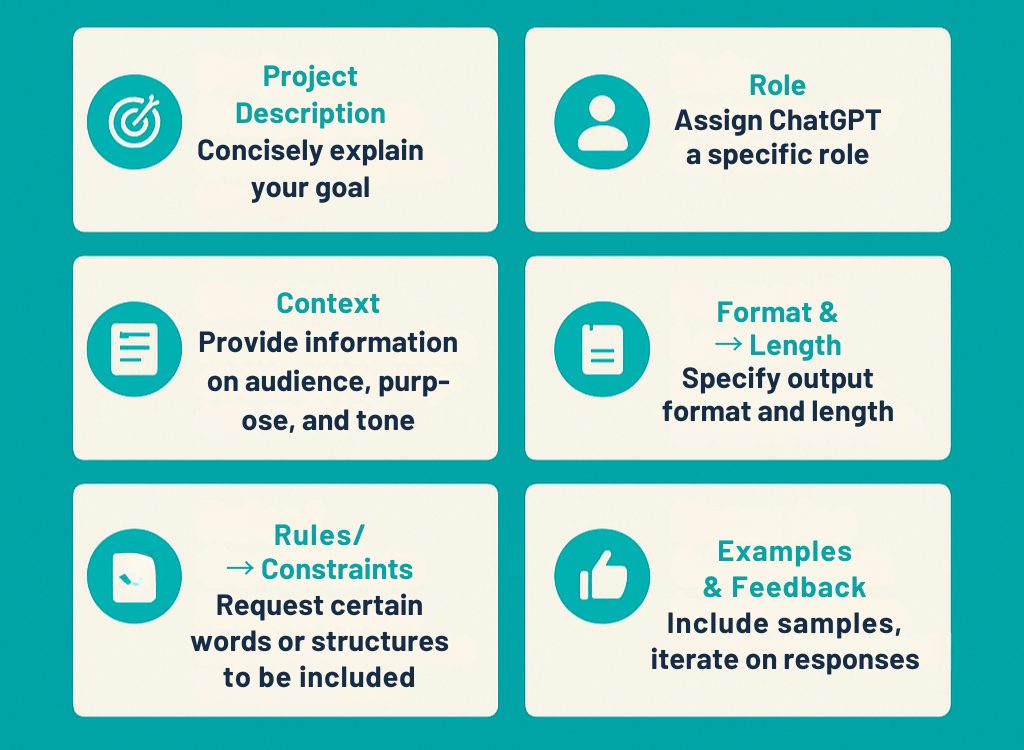Artificial Intelligence in marketing is no longer a futuristic idea: from ideation and content creation to marketing automation, more and more companies are using AI tools to save time and run personalized campaigns. Especially for beginners – those just entering the world of AI – getting started with ChatGPT can be a bit bumpy. This guide shows you how smart prompt engineering helps you unlock the full potential of this AI tool and stand out from the competition.
Why Great Prompts Matter
ChatGPT responds exactly to the instructions you give. The better structured your prompt and the clearer your specifications, the more relevant the result. A well-crafted briefing allows the model to write in the right tone, for the right audience, and in your preferred format – highlighting your USPs instead of falling back on generic phrases. Vague instructions often lead to bland results and miss the opportunities of AI in marketing.
A good analogy: ordering coffee. If you just say "a coffee," you'll get something generic. But if you say "a large oat milk cappuccino, extra hot, no sugar," the barista knows exactly what you want. Prompts work the same way: the more specific your order, the better the outcome.
Core Elements of a Strong Prompt
- Project Description – Briefly explain what you want to achieve. Example: “Write an introductory paragraph for a blog post about sustainable fashion.”
- Define a Role – Ask ChatGPT to adopt a role, such as “You are an experienced social media manager.” This helps shape the tone and style.
- Provide Context – Share details about the target audience, purpose, and tone. Example: “Audience: marketing decision-makers; tone: professional yet approachable.”
- Specify Format and Length – Indicate whether you want a list, paragraph, or full article, and how long it should be. (“List with 5 bullet points, 1–2 sentences each.”)
- Set Rules or Constraints – Mention if certain words should be avoided or specific structure followed. (“Avoid technical jargon.”)
- Examples – If you have a result in mind, add a short example. ChatGPT learns patterns from that.

Advanced Strategies
- Personal Instructions: At the start of a session, share notes like “Our brand voice is witty and clear.” This helps maintain consistency.
- Build a Prompt Library: Save effective prompts for recurring tasks (e.g., Instagram captions, newsletter subjects, SEO copy) and tweak them as needed.
- Summarize Conversations: Ask ChatGPT to summarize past discussions for better clarity.
- Request Alternative Versions: Ask for multiple drafts to compare tone and structure.
- Expert Review Mode: After receiving a draft, ask ChatGPT to take the role of a marketing expert and critique the result. This helps spot gaps and improve quality.
- Emphasize USPs, Avoid Generic Output: Tell ChatGPT to highlight your brand’s unique traits and skip generic filler.
- Try Audio Prompts: You don’t need to type every detail. Speak your ideas naturally – ChatGPT can understand loosely structured thoughts and find coherence.
Best Practices for Marketing Pros
- Be Specific: Avoid vague asks like “Write something about AI.” Better: “Write a 200-word blog post on AI-powered email personalization, friendly tone, second-person voice.”
- Use Step-by-Step Prompts: For complex topics, ask for step-by-step breakdowns (“Explain how to conduct audience research, step by step.”)
- Iterate and Refine: Test multiple phrasing options. Keep refining with each round (“Add a quote” or “Make this half as long.”)
- Keep It Simple: Avoid convoluted sentences or jargon. The clearer the prompt, the better the result.
- Experiment with Models: Try different ChatGPT versions or AI tools to compare outputs.
- Self-Critique Mode: Ask ChatGPT to review and improve its own draft for deeper insights and better quality.
Common Mistakes to Avoid
- Vague or contradictory prompts.
- Overloading prompts with too many instructions – break them down instead.
- Not providing feedback. If the output doesn’t fit, clarify your request.
- Forgetting the context (audience, platform, purpose).
Conclusion
With smart prompt engineering, ChatGPT becomes a powerful partner in marketing and communication. Be precise, offer clear context, and play with roles, formats, and limitations. Ask the AI to take on expert roles for quality control and don’t be afraid to speak your prompts out loud. This approach helps you create standout, SEO-friendly content that resonates with your audience – and gets the most out of what AI can offer.


